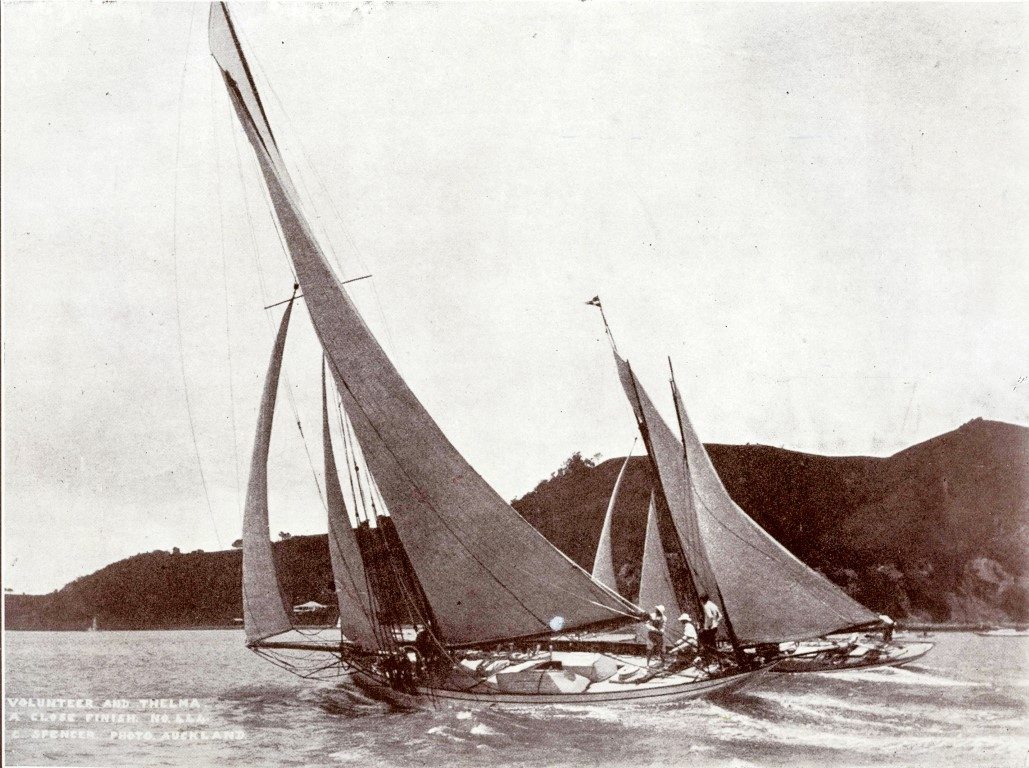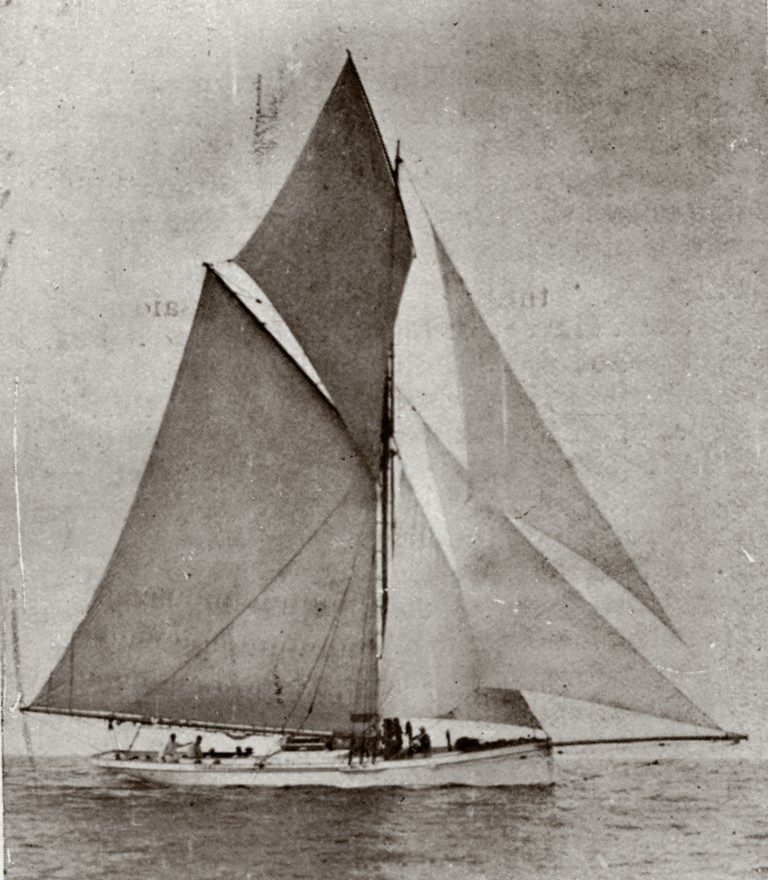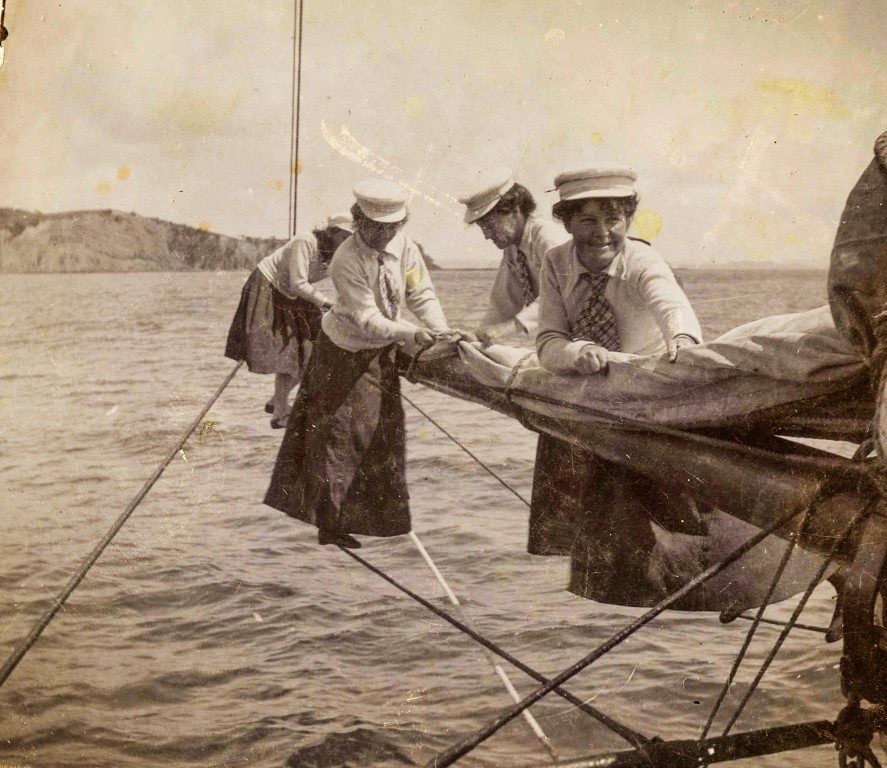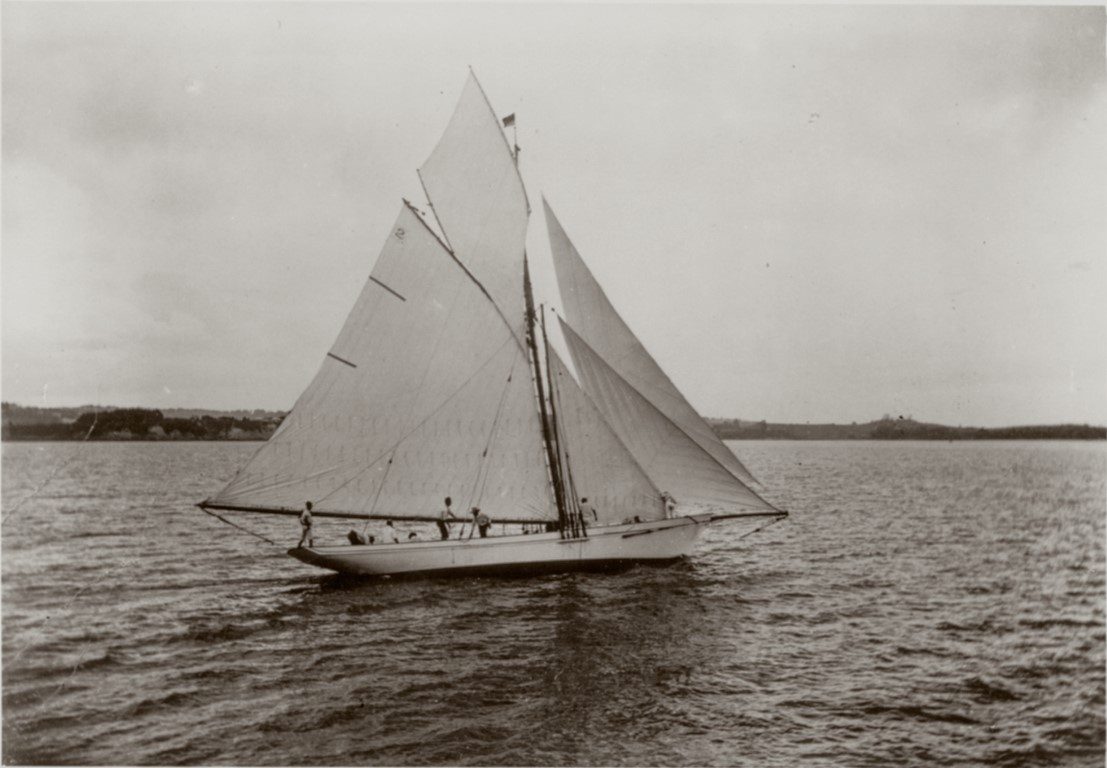

Volunteer was built in October 1888 during a wave of large yacht construction in Sydney in which her designer, Walter Reeks, played a large role. This upsurge of interest in yachting was at least partly attributable to the huge worldwide interest in the recent series of gladiatorial contests in the America’s Cup races off New York.
Indeed, Reeks’ Volunteer was named in honour of Edward Burgess’ America’s Cup winner of 1887. Four of Reeks’ designs – Era, Miranda, Iduna and Volunteer – were built to compete for the big prize money on offer at the Intercolonial/International Regatta to be held at Melbourne in November 1888.

As time was short to get the 33-ton Volunteer down the coast to Melbourne, Reeks fitted her with a makeshift rig from the old cutter Magic, which had a new suit of Ratsey & Lapthorn sails but was too short in the hoist to meet her designed rig parameters, even with seven feet added to the leech.
Under this temporary rig she had come in a close second to her 50-ton sister Era at the Double Bay Regatta shortly before both yachts left for Melbourne. But Era was triumphant in Melbourne. Offshore, Volunteer made the passage back to Sydney in better time than Era.
Their next harbour race was in the Sydney Anniversary Regatta on 26th January 1889 when they were the only entrants and collided shortly after the start. Volunteer lost her topmast gear and won the protest. On February 6th and collided shortly after the start. Volunteer lost her topmast gear and won the protest. On February 6th she met Era again, in a hard southerly breeze and, “notwithstanding that her mainsail appeared more like a bag than a racing sail”, defeated Era easily.
Shortly after Volunteer was launched at Drummoyne, Reeks had left on a trip to England and the US to investigate the viability of constructing an Australian challenger for the Cup. As soon as he was back in Sydney after the January race, he made trim modifications to Volunteeer to improve her performance.
Often with Reeks at the helm of Volunteer, the two yachts raced the rest of the season on give and take terms. There was a report in April 1889 that Volunteer was to be sent to San Diego “to race Spreckel’s yacht Lurline, provided £400-500 can be raised among local yachtsmen to cover expenses”, but nothing came of it.

During that winter her owner, W.P. Smairl, installed a new Reeks-designed rig, spars, gear and Ratsey & Lapthorn sails in Volunteer. She was immediately superior to Era which was withdrawn from racing for a while. Volunteer became the Sydney “crack”.
The economic situation in Australia became dire. Smairl put Volunteer up for auction in August 1891, but she was passed in it at £960, less than the value of the lead on her keel. This generation of Australian racing cutters was being sold off as fishing and pearling boats or Pacific Islands’ traders for a song. Eventually, in January 1893, it was announced that Tom Henderson of Auckland had bought her at an undisclosed price.
Tom Henderson was the son of Thomas Henderson, the founder of Henderson and Macfarlane, who ran the Circular Saw line of vessels in the timber and Pacific trades. Tom junior was the Auckland manager for the Union Steam Ship Company. He was well-known for his yacht Rita, a 45ft cutter Charles Bailey St built for him in January 1882.

Henderson had given Bailey a tight budget for the big boat. She was built to the current Thames or tonnage rule, very roughly finished and of composite construction, unusual for Auckland. Rita had many exciting battles on the Waitemata with the big Robert Logan keelers – Aitken and Kissling’s Toroa (1881), C.H. Street’s Muritai (1882) and particularly Arawa (1882), owned by J.L.R. Bloomfield. Tom was a very keen cruising man too and put up prodigious mileages every summer in North Auckland waters, usually in company with the Bloomfield brothers in Arawa.
By 1893, Rita was becoming outclassed. In the wind, too, was the prospect of a major race in Auckland. The yacht clubs in Auckland, Wellington and Lyttelton had agreed to a series of “First Class Championships of New Zealand” to be held annually to encourage the major yachts to sail around the coast to each event. This was probably inspired by the many entries in the 1888 Melbourne event where Volunteer had cut her teeth.
The first Championship race was held in conjunction with the Wellington Anniversary Regatta in January 1892. Lyttelton’s Mascotte won, beating the Auckland yacht Maritana and Mima from Wellington. The 1893 event was a sail-over for Mascotte at Lyttelton, with no outside entrants.
Auckland’s turn was slated for its Anniversary Regatta in January 1894. It was in this background that Tom Henderson took the step of buying one of the finest Australian yachts and sailing her to Auckland in preparation.

After a stormy passage of 16 days Volunteer arrived from Sydney under yawl rig in charge of Capt. Delmer on 17th January 1894.
With a rating of only 23 tons, Viking had a handicap March advantage of 10 mins 14 secs on Volunteer on 33 tons over the 46-mile course. In a half gale southwesterly, with eased sheets, Volunteer had cleared out by the turning point at Tiritiri and was 12½ minutes ahead as she passed the Motuihe mark, where the only other entrant, C.H. Lushington’s Muritai dropped out.
On the wind, back to the finish mark in the harbour, Viking pointed much higher and made ground fast, crossing the finish line just two minutes behind, winning easily on handicap. It was a popular victory for the Auckland-built boat on her first race, despite the fact that Volunteer had led from start to finish!

In the following years, both Volunteer and Viking did a great deal more summer cruising under yawl rigs than harbour racing under their big cutter rigs. The two yachts met again in the 1895 Auckland Regatta. Volunteer narrowly crossed the line ahead of Viking but could not make up the seven minutes 32 seconds she had to give away.
In the 1896 event Volunteer got across the line 14 minutes ahead, easily making good her allowance of eight-and-a-half minutes to Viking but both were giving a lot of time to the new raters Aorere and Halcyon which were disqualified in a curious Committee decision. Little wonder that the First Class race of 1897 fell through from lack of entries.
Tom Henderson was now spending most of his time with the Union Steam Ship Company in Australia. There was talk of selling Volunteer to a Wellington purchaser, hiring her out for the season, or laying her up. She spent most of the next four years laid up, taking the occasional race when Henderson was in Auckland or being the mark boat off Judges Bay for yacht races.

In May 1901 she was sold at auction to Alex Alison of the Devonport Steam Ferry Company for £340, a fraction of her original cost. Alison raced her frequently and used her extensively for cruising and picnicking. By now she was up against the latest Logan big raters like Rainbow and Thelma but managed to hold her own on occasion if the conditions were right.
However, Alison sold Volunteer to Chris Hennings of Fiji in August 1905. After many months cruising locally, Volunteer was fitted out for her long voyage and sailed for Fiji on 17th April 1906 with a smart passage of six-and-a-half days. Unfortunately, Hennings died shortly after, leaving Volunteer to his nephew. She was broken up at Levuka in early 1908, realising more for the lead on her keel than Hennings had paid for her.
Charles Bailey Sr’s masterpiece Viking had a better fate. She is still afloat in rude health in the hands of the Todd family of Wellington.




